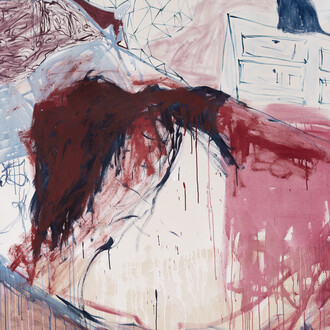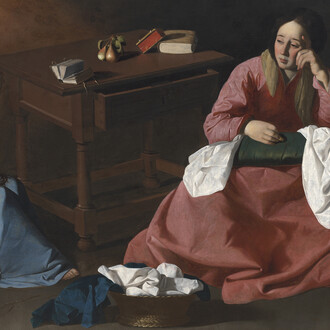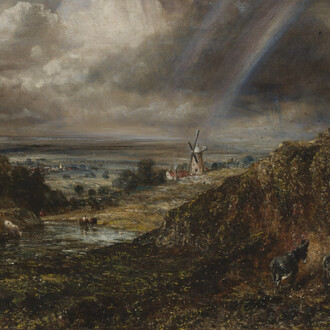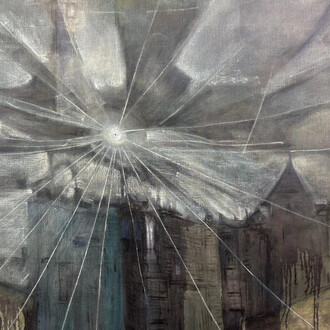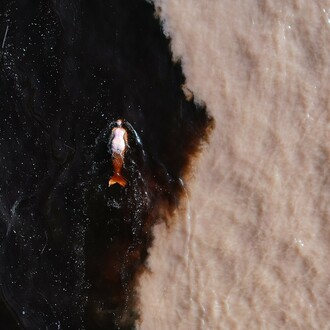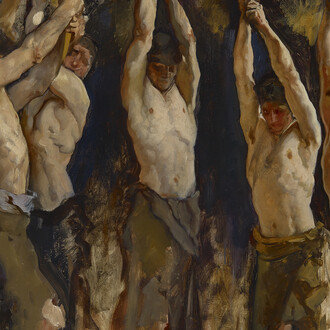Jonathan Okoronkwo’s (b. 1993 in Aflao, Ghana) paintings are products of the scrapyard, specifically Suame Magazine, one of West Africa’s largest industrial zones, located in Kumasi, Ghana. Here, the artist encounters machine parts light years away from their previous lives as motor vehicles. They are disassembled, organised and presented according to type, from nuts and bolts to head gaskets, steering wheels and engines. Okoronkwo photographs and digitally assembles images of these various parts to create painterly compositions that explore both the promise and failure of machinery, as well as the fragility of its systems.
In 1902, the first motor vehicle arrived in the British colony of Gold Coast, today Ghana: a paraffin-fuelled and steam-driven French Gardner-Serpollet car for Governor Matthew Nathan. The car was a symbol of luxury and Western modernity as well as colonial governance. However, the poor conditions of Gold Coast roads meant there were limited opportunities for this fragile car. After six years of neglect, it was thrown into the sea in a massive cleanup of Accra in 1908.
In that same year – 1908 – the first Ford Model T was produced at the Piquette Avenue Plant in Detroit, Michigan. The ‘Model T’ was hailed as the world’s first affordable automobile, democratising transportation and vehicle ownership. Ford’s innovation was global in scope, as motor transport technologies spread across the Atlantic and through networks of trade and empire. While Nathan’s car laid to rest at sea, African drivers in colonial Ghana adopted imported motor transport technologies, leading to seismic changes in society.
A year after the introduction of the Ford T-Model – 1909 – the publication of the Futurist Manifesto by Italian artist Filippo Tomasso Marinetti glorified the automobile and the beauty of speed. The car had become the vehicle through which to leave the old world behind. Okoronkwo’s title for the exhibition responds to Rudyard Kipling’s 1911 poem The secret of machines, which also celebrated modern technology in the wake of the Industrial Revolution in the United Kingdom. Two decades later, for Detroit industry (1932–33), a 27-panel mural cycle for the Detroit Institute of Arts, the Mexican artist Diego Rivera painted the production of the Ford V8 at its River Rouge Plant. He had spent three months touring the Ford plants, preparing hundreds of sketches and concepts for the mural. Rivera’s detailed depictions of assembly-line production and machines project the harmonious synthesis of human and mechanical action.
The idea of the automobile similarly propelled Ghanaian independence, as encapsulated in Kwame Nkrumah’s popular slogan “Forward Ever, Backward Never.” Mobile vans took films and political propaganda into villages throughout the country, incorporating rural populations into the larger nationalist project. Where commercial drivers had become a symbol of the democratisation of automobiles in the early twentieth century, in the years after independence, a new form of public transportation appeared on Ghanaian roads: the trotro. Originally named for the three-pence fare they charged for travel within the boundaries of metropolitan Accra, today these vehicles still transport goods and people within and between the villages, towns and cities of Ghana.
The trotro is what originally drew Okoronkwo to the scrapyard, the site where these vehicles are transformed into passenger transportation. Most trotros are second-hand automobiles imported from the West, where they operated previously as small buses, mini-vans or converted pick-up trucks, and sometimes even ambulance cars. The trotros operate according to their own system, and one must learn this language in order to navigate them: they have no set routes and no written schedules. There is a photographic sensibility to Okronkwo’s compositions, as if cropping one section of a larger image, evoking the presence and absence of these other ghost passengers.
The idea of transformation embodied in the trotro and its concomitant labour is integral to Okoronkwo’s work. His paintings exaggerate the size of joint connectors – such as nuts, bolts and gaskets – equalising their visibility to, say, an engine. Okoronkwo’s emphasis on these connectors is linked to an exploration of systems and the way each component plays its part. The artist is also interested in the transformation of materials used to make machines: metals start out as raw materials – in the case of steel, they include iron ore, coal and limestone – formed in the earth’s crust billions of years ago from marine debris and photosynthetic organisms. These raw materials are mined, smelted in the blast furnace, processed and cast into a final product. Okoronkwo chooses to paint on plywood as a kind of homecoming, returning these inorganic materials to their former organic state.
Like the systems that govern the trotros, Okoronkwo has had to learn the rules of the Suame Magazine scrapyard while working there as an apprentice for over a year. This experience allowed him to build relationships and gather images and pigment from which to paint, including motor oil from the engines of trotros, which are often pushed beyond their limits, turning the oil into a thick black paste, as well as machine parts dissolved in an elixir of sulfuric and nitric acid to create different colours. Okoronkwo’s titles are taken from snippets of conversation overheard in pidgin, a mixture of English and local languages used by people who do not share a common tongue. The fragmented nature of the language is a product of labour migration that was accelerated by the speed and scale of motorised travel. These texts also enter the paintings themselves and demonstrate the way instructions are translated between languages in the scrapyard.
Okoronkwo has simultaneously sought to circumvent the structures of the capitalist system. He has exhibited his work at the scrapyard, challenging the direction of travel in which machine parts are solely extracted from the site. In Kipling’s The secret of machines, modern machinery is praised for performing its tasks twenty-four hours a day. By contrast, Okoronkwo’s exhibition title – Ask not what we were made for – challenges the valorisation of commodities and services based on their exchange value. His dense mazes of machine parts do not serve a motor vehicle. Rather, Okoronkwo’s body of work pushes the idea of transformation one step further: his paintings extend machine parts beyond their mechanical means and exchange value and deploy them to tell a story of local specificities and global entanglements. If, in the past, the automobile was connected to a teleological narrative of progress, in Okoronkwo’s work, it is a site of endless experimentation and reinvention.
(Text by Gabriella Nugent)









